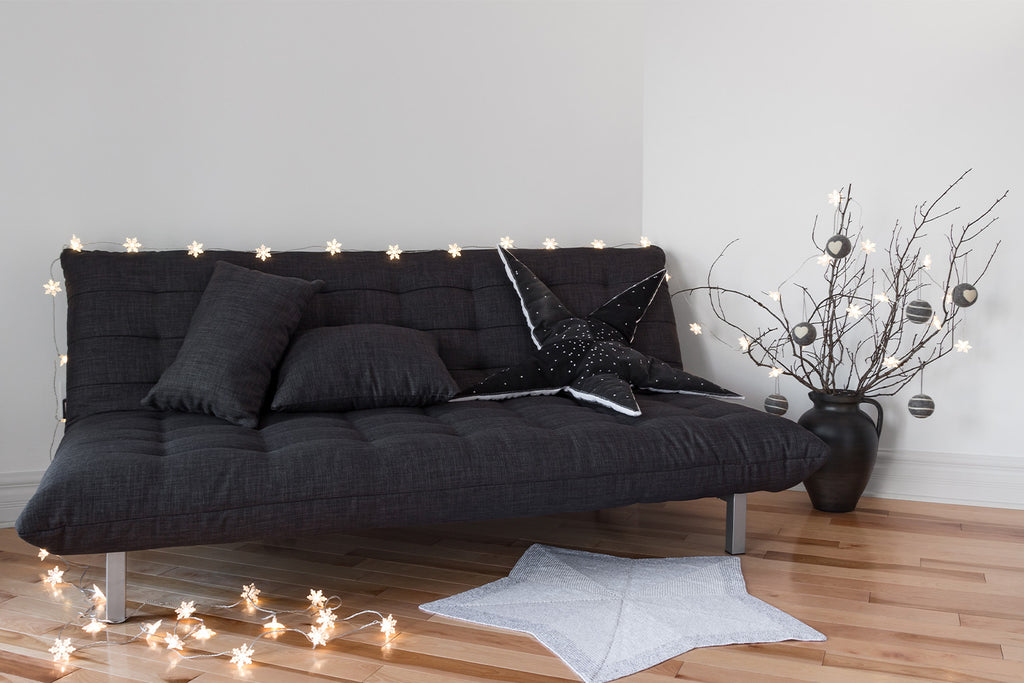
How To Make a Futon More Comfortable

Futons are great options for smaller spaces; they tend to be less costly and are great for easily moving around in smaller spaces. Just like any mattress, though, sometimes futons can become deflated, old, and overall less comfortable than they once were on the initial purchase.
This is perfectly normal, and there are a number of creative ways to fix this issue. The first and simplest answer is to purchase a new one. A high-quality option like the Cream Faux Shearling Futon is as comfy as it is beautiful.
Read these tips that may make your futon even more comfortable than it already was at its best.
What Is a Futon?
Before jumping into some of our tips, maybe you made your way to this article after trying to figure out what a futon technically is! We’ll break it down for you:
Futons are a type of traditional Japanese bedding. They are typically known for how easy they are to store since you can roll them up with ease and tuck them away under a couch, in a closet, or any other storage space during the day. The word itself comes from the Japanese language and refers to a cushion filled with certain materials, such as cotton.
This type of bedding typically has three layers, one that offers support, a middle layer for additional comfort, and then a protective layer or cover. There are also different types of futons. The traditional Japanese-style futons can be placed on the ground and are frameless. They’re incredibly lightweight and easy to stow away, and most of the futons' famous qualities come from this original version.
Other types of futons look like sofa beds. These have more support on the bottom and typically can be converted from a makeshift sofa into a flatbed. While these are also very common, they are much weightier than typical futons and don’t possess the same standard qualities that are expected of a futon.
Now that you know what a futon is, let’s review how to make them even more comfortable.
Pile on Extra Blankets
If you find that your futon is becoming less plush and comfortable, one of the easiest ways to add some extra relief layers is to use a couple of blankets on top of the futon. Grab any blankets that you have lying around the house for this technique.
Here are a couple of ways that you can use the blankets to make your sleeping experience even better on the futon:
- Fold some blankets vertically below the futon to add extra layers below your body.
- Create a line of blankets wrapped around the futon to provide some extra cushioning and support around yourself.
- Throw three or four blankets over the top of the futon to insulate yourself more; nothing wrong with using them in the traditional way they are supposed to be used!
Blankets should be a quick and hassle-free way to make your futon more comfortable.
Make Use of Pillows
Another easy method that you could make use of to make a futon more pleasant is to grab any extra pillows that you may have around your house or in your bedroom. Either add the pillows to certain areas of the futon that you feel need more plushness and support or evenly distribute them below the futon for some support across the entirety of the bedding.
Bed pillows — memory foam, latex foam, jacquard pillows, and more — can go far in making your futon feel much more suitable for sleep.
Change the Position
Sometimes the issue with your futon could be where you actually have it placed in your room. Maybe the spot you have it in is too flat surfaced or is not one that is going to provide you with ideal comfort.
Try moving your futon to an area that seems softer in the room. This could be an area that is carpeted, for instance. Another thing that may help elevate your sleeping experience on a futon is pushing it up against a wall. This way, you could stack some pillows up against the side that is touching the wall, creating a sort of nook in the corner of the room for yourself.
Lastly, perhaps flip the futon so that your head is where your feet used to be. All bedding — including mattresses — can benefit from being rotated.
Add an Ottoman at the Bottom
This tip is geared towards our taller sleepers out there, but if you are sleeping on a futon that resembles a sofa bed and you find your legs are dangling off its edges every night, consider adding an ottoman right where your feet would normally be hanging off.
We want our full bodies supported by whatever form of bedding we choose to get our rest, so make sure that your futon has an adequate amount of space for you and anyone else who may be using it. Additionally, if you have a futon resembling a couch, an ottoman will make for a great footrest during the hours you use it as a couch.
Add a Memory Foam Mattress Topper
This may be one of the easiest and most effective ways to heighten your futon’s comfort capacity. A mattress topper works wonders for those who have mattresses that are feeling a little old and tired.
It can do the same for a futon that needs a little extra support! Just toss a memory foam mattress topper beneath wherever you keep your futon, and you should immediately feel a difference upon making this switch up.
Memory foam forms itself around the body lying on top of it, so it helps to add an extra layer of support (if that is what you seek). Memory foam is also fantastic for insulating any body heat. So, if you have been struggling to keep warm with just your futon and any other bedding you have during sleep, the mattress topper should help with this issue.
Use Extra Comforters
If you do not have a mattress pad or don’t wish to go out and buy extra bedding, another option is to grab an extra comforter that you have lying around the house and bundle those up to sit beneath your futon.
Comforters tend to be fairly thick and soft, so using one to three of them folded below your futon will hopefully impact the quality of sleep you get from a futon.
This is very similar to the previous tip mentioned above with using any extra blankets you have, some you can use the ideas from there to achieve maximum comfort. The only difference is that a comforter, even just one, could create much more support than a couple of blankets would.
Add an Air Mattress
Are all of your comforters already being put to use elsewhere in your house? Don’t have a mattress topper to throw beneath the futon? Another quick and simple solution for a futon that is not as comfortable as you would like it to be is to put an air mattress beneath the futon.
While it may seem a bit odd at first to do so, using an air mattress might be effective in heightening the comfort you get out of your futon. Air mattresses are generally simple to assemble and can be moved from one corner of the room to another due to how lightweight it is. An air mattress could also add some extra surface area for you to sleep on if you find that your futon does not provide the space you need.
These Tips Aren’t Working?
If you have tried all of these and you feel that your futon is still not as comfortable as you would like it to be, it may be time to consider buying a new futon. Just like mattresses, futons can get old and lose the initial amounts of softness and comfort that they once provided.
If you are in the market for a new futon, we have a perfect one here at eLuxury! Click here to learn more about the product and what it offers.
The Tips To Remember
There are plenty of ways that you can make your futon more comfortable if you feel like it needs a bit of an extra adjustment. Some of the simplest and most effective choices are adding a memory foam topper beneath the futon, an air mattress, or using some extra pillows or blankets to create some more support.
You could even use some comforters that you have in the house if none of these other options are available to you. If you find that none of these are working for you, consider replacing your futon.
Sources:
What is Memory Foam? | Sleep Foundation
How to Blow up an Air Mattress With a Large Opening | SF Gate
10 English words that were originally Japanese | Japan Today




